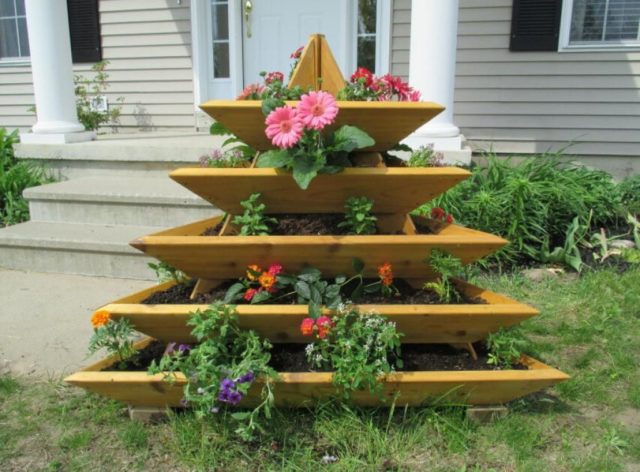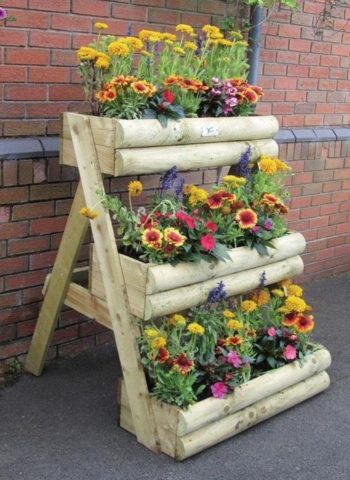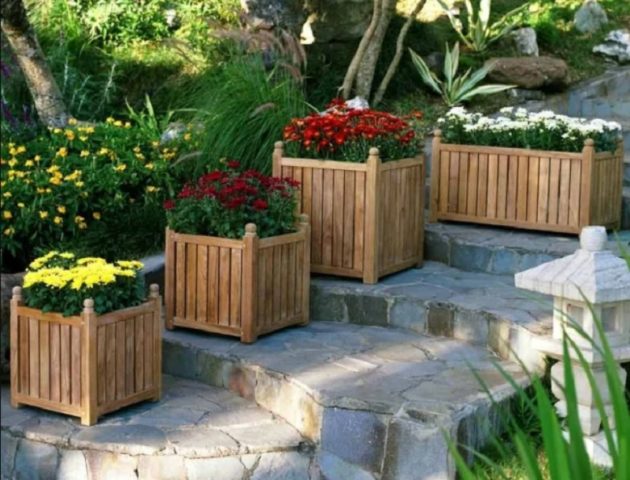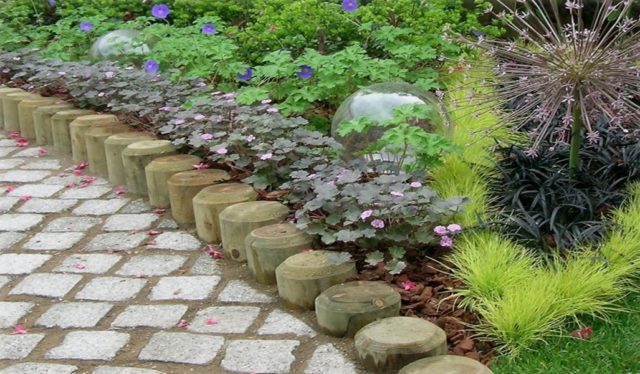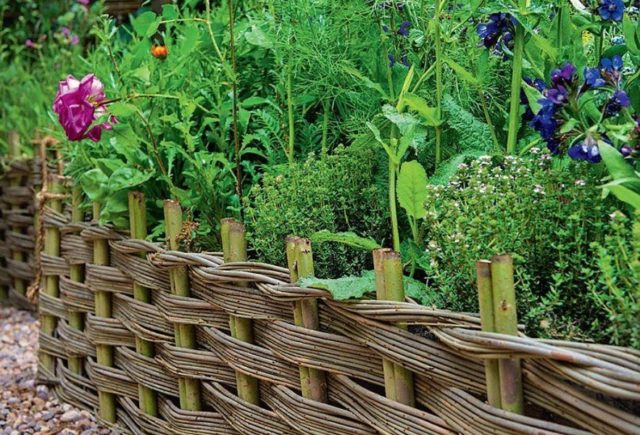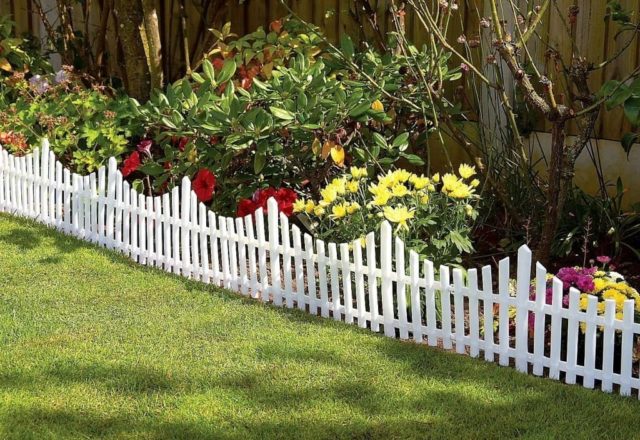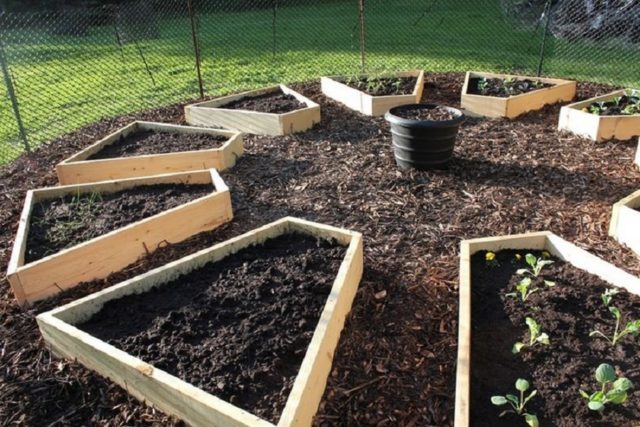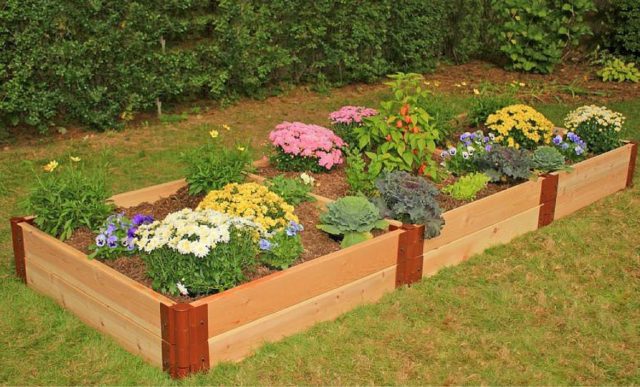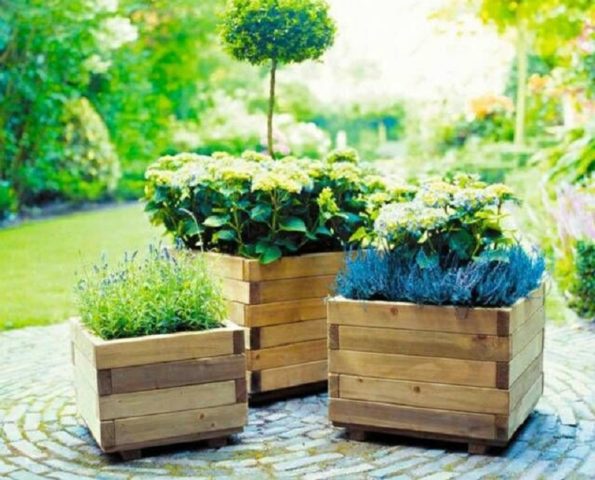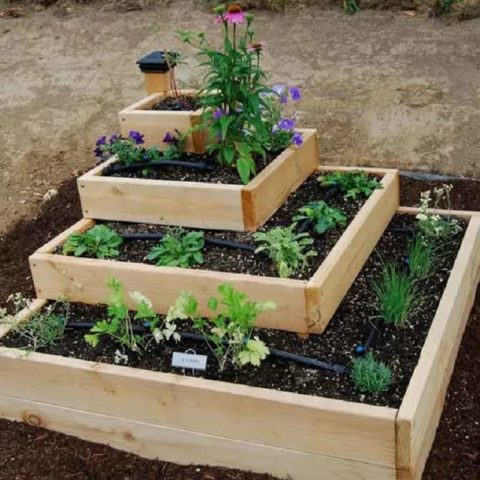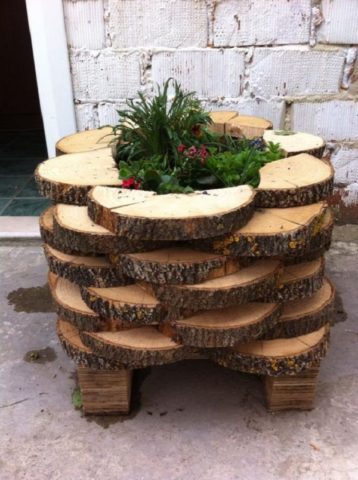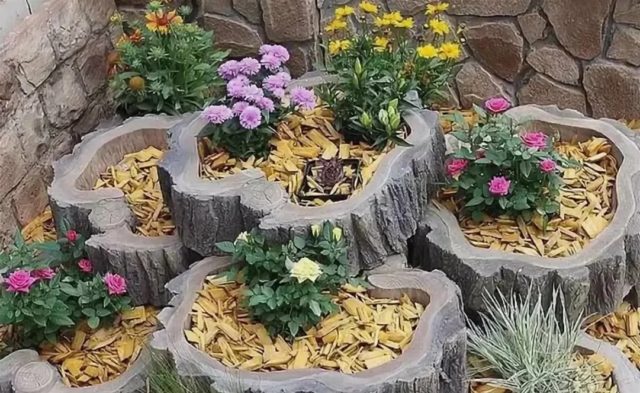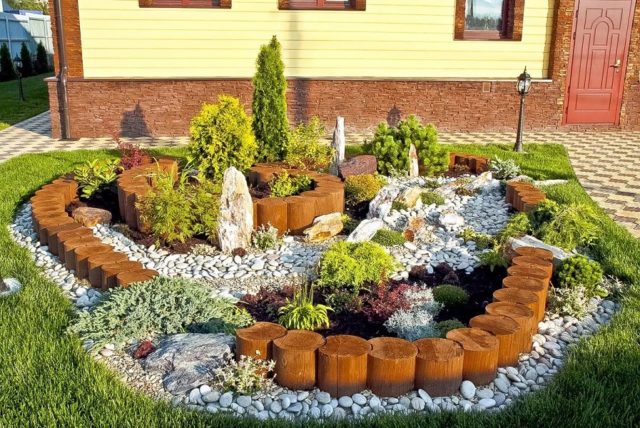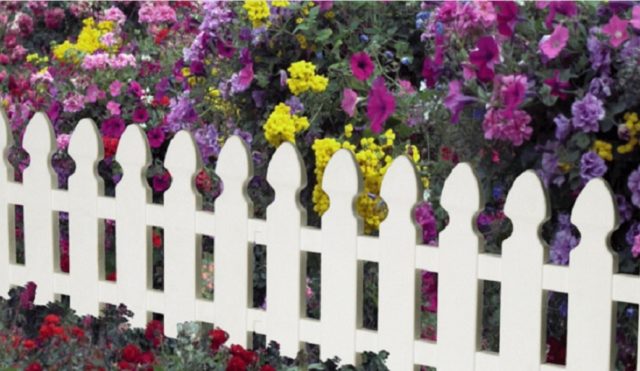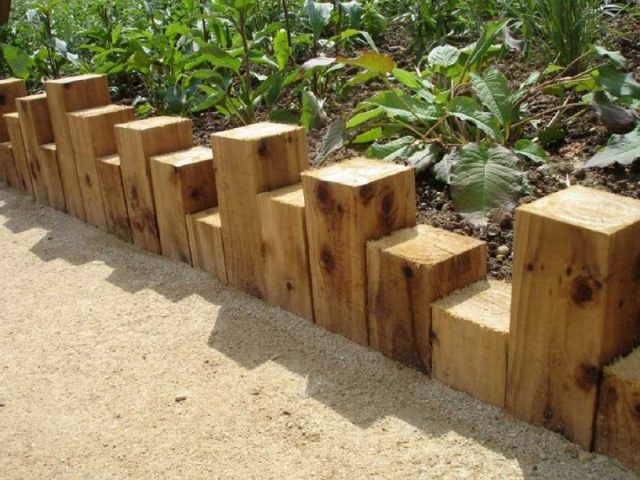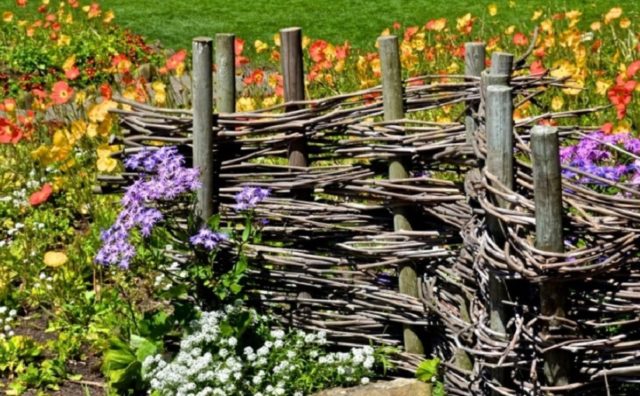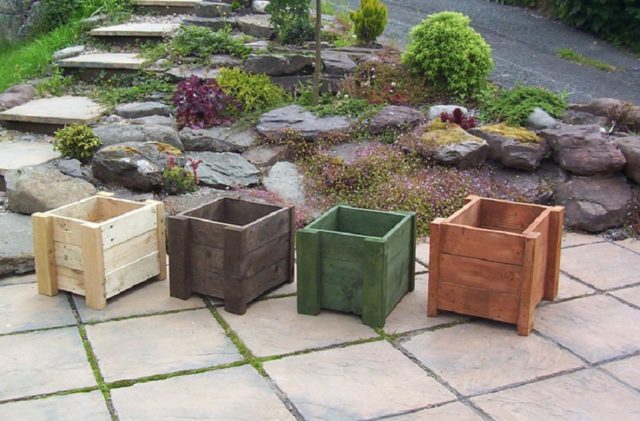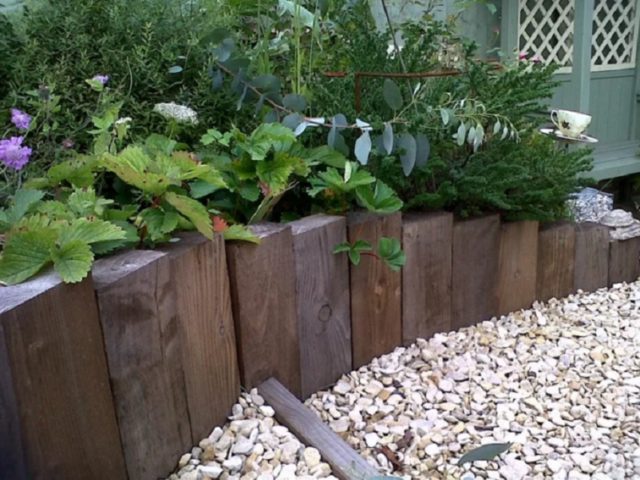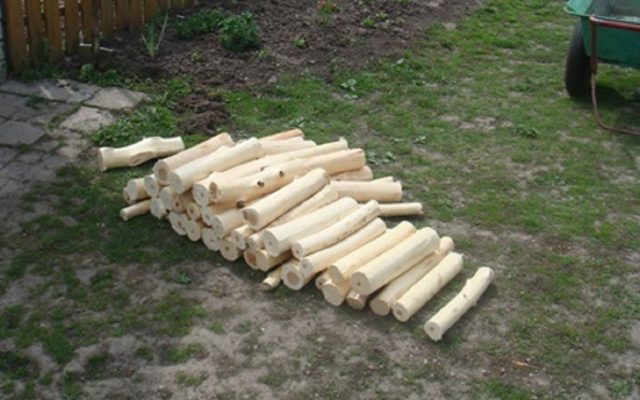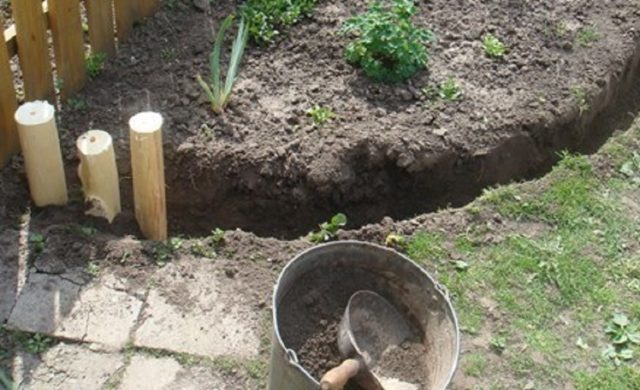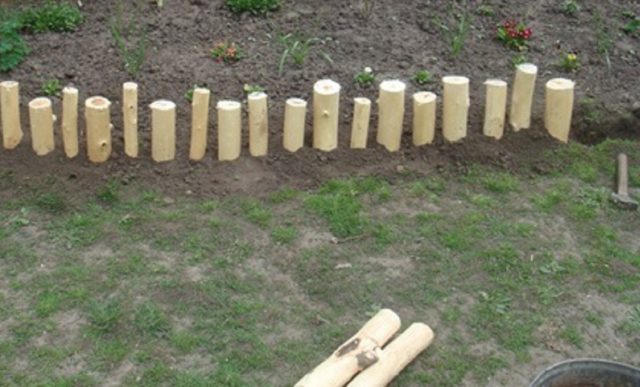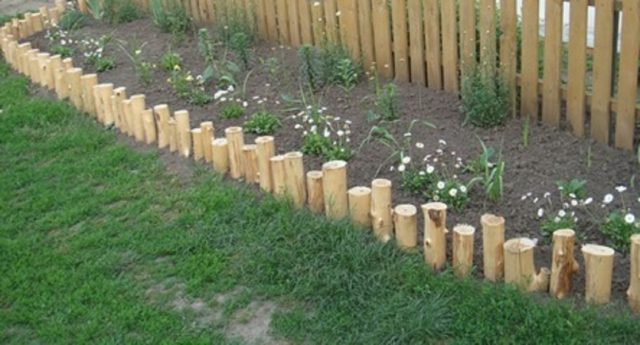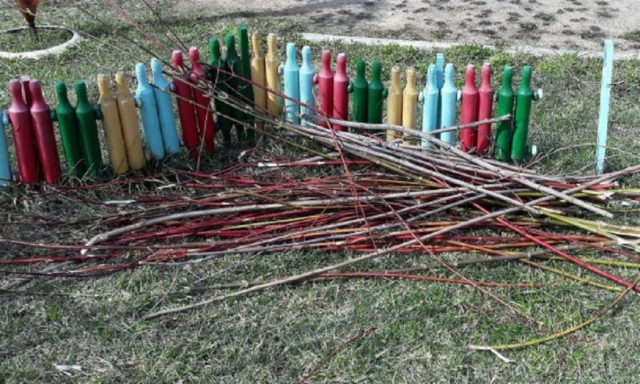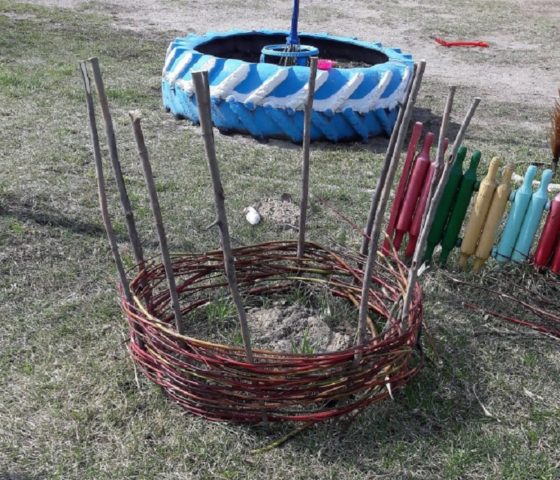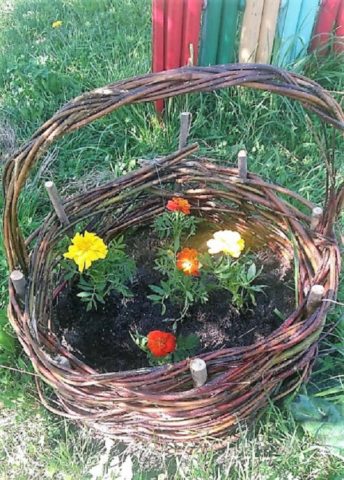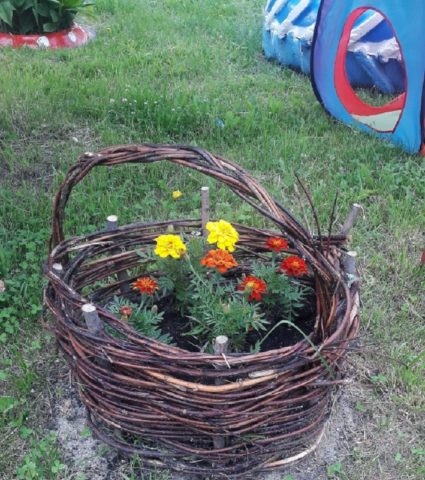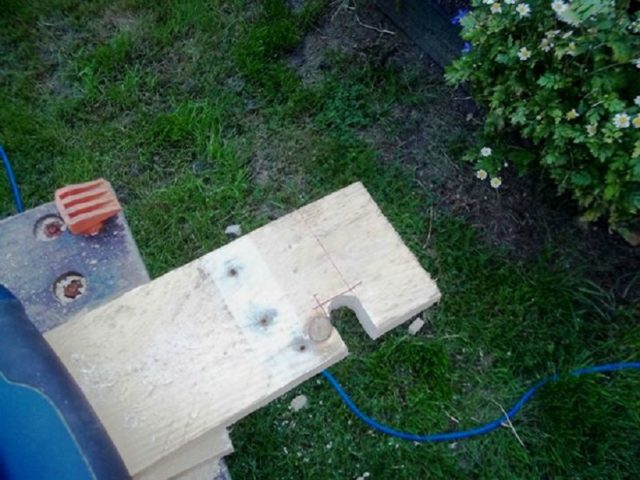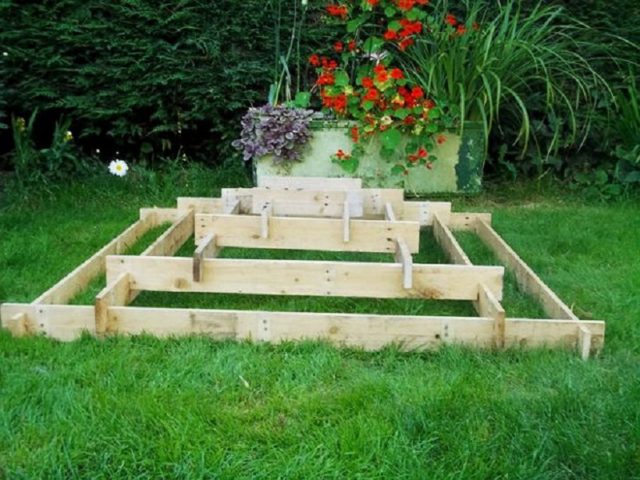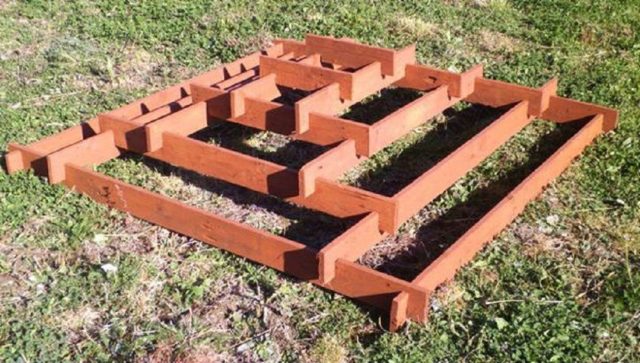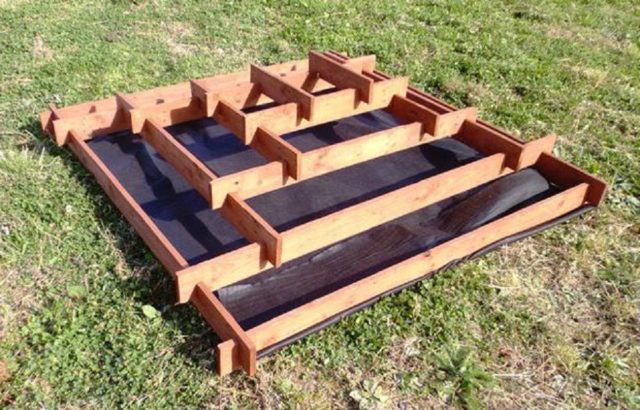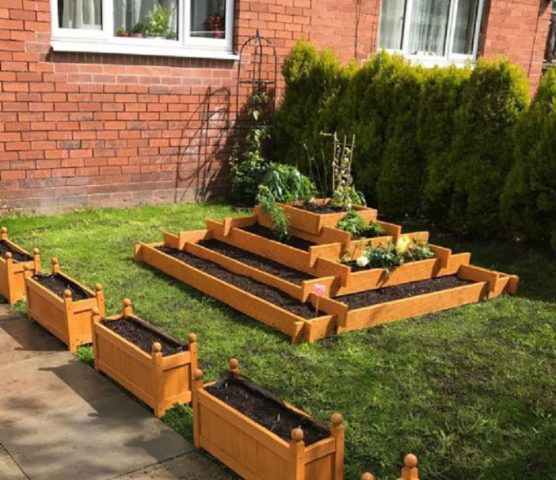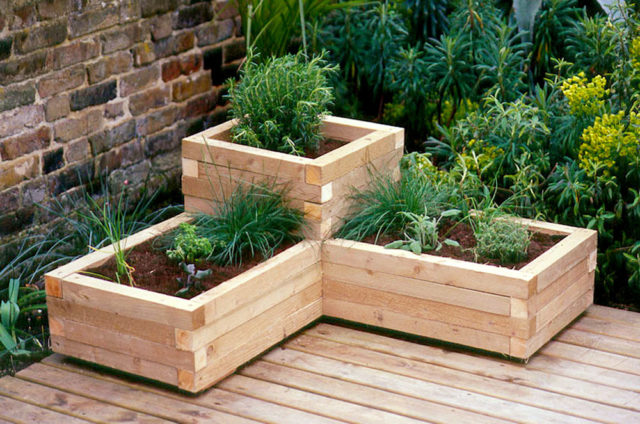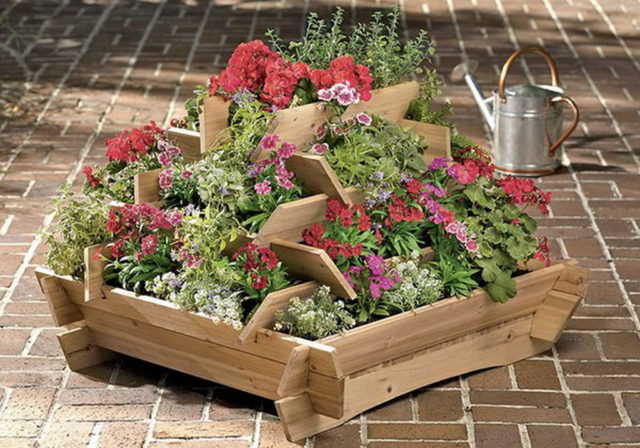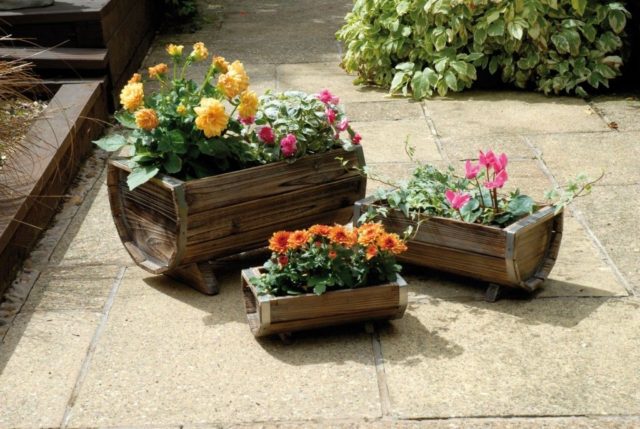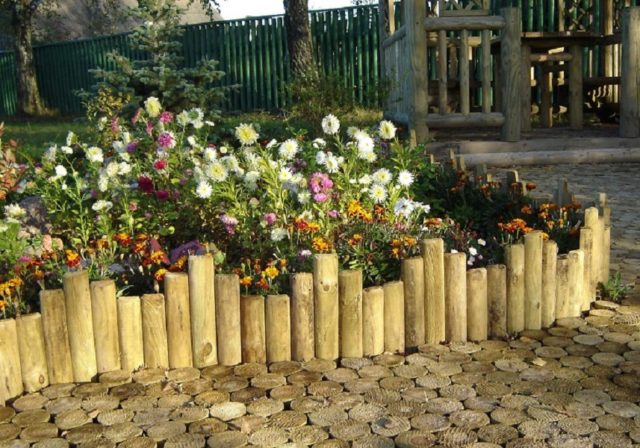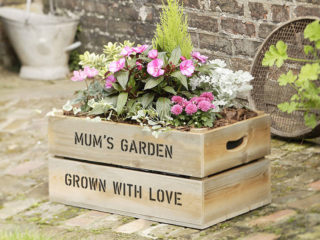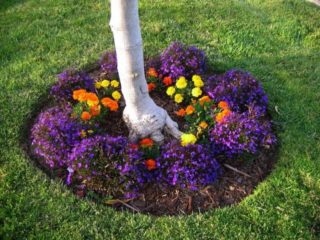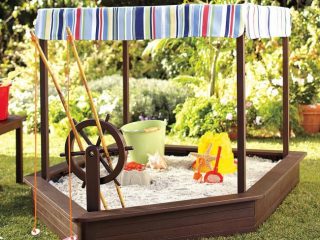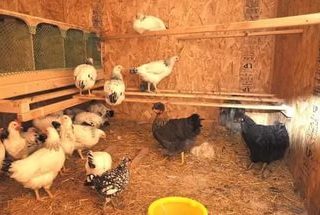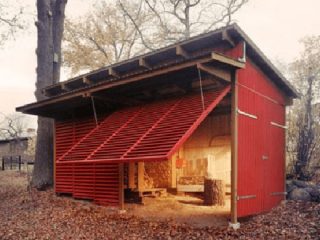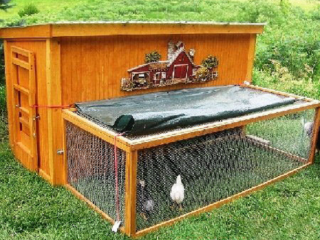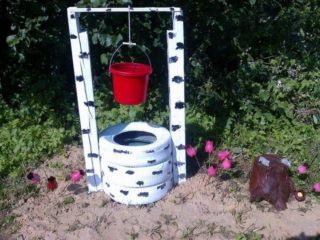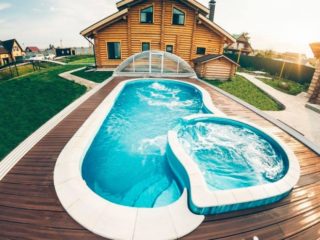Content
- 1 Pros and cons of wood beds
- 2 Beds of boards for flowers
- 3 Flowerbeds made of wood cuts
- 4 Flowerbeds of stones and wood
- 5 Decorative fences for flower beds made of wood
- 6 Flowerbeds of tree branches
- 7 Plank beds in the form of an animal
- 8 A flower bed of scraps of boards
- 9 Flowerbed made of wooden pegs
- 10 Photo of wooden flower beds with your own hands
- 11 Conclusion
Beautiful plantings are an integral decoration of the landscape of any summer cottage or personal plot. But even the most beautiful flowers can spoil the impression if they are planted chaotically and grow in the wrong place for them. That is why it is important to organize a flower garden. For this purpose, you can use a variety of materials, but the use of wood is considered the most successful. Numerous do-it-yourself photos of flower beds from boards prove that such landscape decoration is no less interesting than that created by professional designers.
Pros and cons of wood beds
Wood, as a material for various types of structures, including flower beds, has its own advantages and disadvantages. If we talk about the advantages of flower beds made of wood, then the following aspects can be distinguished:
- environmental friendliness - the material itself is completely safe for humans, plants and the environment (even after rotting, a tree can become an excellent fertilizer for flowers);
- safety for plantings - the tree does not heat up in the sun and does not freeze, which makes it possible to additionally protect the roots of plants;
- availability - wood is a fairly common material, which also has an acceptable cost, moreover, it is not at all necessary to use new wood;
- simplicity of manufacture - the material itself is easy to process, therefore, it is quite easy to make a flower bed from it with your own hands, a fence of any shape and size;
- aesthetics - a flower bed can be made of various types, while it is possible to leave the tree uncoated (in its natural form) or paint it in the desired color;
- versatility - the tree is suitable for decorating flower beds in a variety of styles.
Among the disadvantages it is worth noting:
- fragility - since the material without certain processing is quickly susceptible to decay, damage by microorganisms and various insects;
- constant care - wood, as a short-lived material, requires annual treatment with special agents or staining to maintain its original appearance.Important! When arranging any flower bed made of wood, the material needs preliminary treatment with special compounds: an antiseptic, oil or paint and varnish products.
- Varieties of decorative wood beds
They make a flower bed with their own hands from a tree in a country house or a personal plot of the most diverse format. It can be stationary or mobile. At the same time, flower beds of the second type make it possible to install them each time in a variety of places, for example, near the entrance, under a window or a tree. Also, a big plus of mobile flower beds is that they can be put away for storage in the winter season, which will significantly extend the service life of such a structure.
Depending on the shape and location, flower beds decorated with wood are also divided into types. So, for example, the simplest one should be highlighted - this is a classic flower garden (flower bed), which is traditional.It is made of a certain geometric shape (circle, oval, rectangle or polygon). It can be installed in any convenient place, usually at the entrance or under windows.
No less popular is a wooden border for a flower bed. This structure differs in location, as it is usually lined up along the paths.
Another most popular option is a fence, while it can be of several types:
- palisade - a fence made of stakes that are driven into the ground tightly enough to each other or at a short distance;
- wattle - a fence made of thin and long branches or shoots of shrubs;
- picket fence - made of vertical planks fixed to a horizontal bar.
- DIY ideas for flower beds from boards
Despite the simplicity of the material, you can still make a variety of flower beds from wood with your own hands. For example, planks can make unusual fences or classic geometric flower beds. But the cuts are suitable as decoration or decorative elements for the design of a flower garden. All creation options directly depend on imagination, and some examples will be described below.
Beds of boards for flowers
Do-it-yourself flower beds from wooden boards are the simplest designs. This option is suitable for the design of absolutely any site, regardless of its area.
Shaped flower beds can be made from such material, for example, in the form of a square or polygon. This will require a certain number of boards, for a square it will be enough to take only 4 pieces, and for a polygon - depending on the number of its sides. In this case, the length of the board will be the height of the flower bed itself.
It will be a little more difficult to complete a sandbox flower bed from boards. The principle of its construction is similar to the first option, but in this case the manufacturing process itself resembles the creation of a frame, similar to a children's sandbox.
It is interesting to make beautiful small flower beds from boards in the form of boxes. Their advantage is mobility, since basically such flower beds can be moved around the site, and completely cleaned in the winter.
Also, with the help of boards, you can make multi-tiered flower beds. Such flower beds look spectacular, while they practically do not require construction costs.
Flowerbeds made of wood cuts
In addition to boards, you can also use tree cuts, which also allow you to create original flower beds. Such elements are quite good for decorating flower beds made of other materials with wood.
From large cuts (logs), flowerpots can be made by removing the core. This void is then filled with soil. Despite the initial unkempt appearance, after planting the plants, the flowerbed looks very noble and harmonious, blending in with the environment.
Flowerbeds of stones and wood
Combined design options for flower beds are no less attractive than made exclusively of wood. For example, a filling of stones around can be a good combination. Thus, you can create something like a rockery.
Decorative fences for flower beds made of wood
Do-it-yourself wooden fences for a flower bed are the simplest design option for a flower garden. Such a fence always looks impressive and quite interesting. In this case, the design can be made very different, for example, if you use pegs, logs or a carved picket fence.
Often, flower beds are enclosed with a more voluminous fence made of wooden beams. This solution is very original, allowing you to clearly separate the boundaries between the space of the site.
Flowerbeds of tree branches
Unusual flower beds of tree branches, or as they are also called wattle, are very attractive. Basically, a similar structure is installed in the form of a hedge (decorative fence), but it is also possible to create flowerpots or flower beds in the form of baskets.
To make the most of a wicker wooden fence for a flower bed, made with your own hands, you can plant decorative sunflowers next to it. In addition, the combination of a wicker fence with wildflowers looks great.
Plank beds in the form of an animal
Since wood is a material that can be easily processed, you can make with your own hands not only simple flower beds in the form of geometric shapes, but also more interesting ones - carved ones. These include flower beds in the form of animals, for example, a swan, a dog, an elk made of plywood or solid wood. This kind of figurine can be made in a variety of ways, but you need to be able to handle a jigsaw.
A flower bed of scraps of boards
If, after repair or construction, unnecessary trimming of the board remains, they will also come in handy for creating an original flower garden with your own hands. In this case, you can make a low and simplest fence for a flower bed from board scraps. Or collect neat small boxes that can be placed under a window or near a bench.
From scraps of boards of different lengths, it is possible to make a kind of flower bed in the form of a ladder or a pyramid.
Flowerbed made of wooden pegs
Another simple type of fence for a flower bed or a large flower garden is a palisade, which is a low fence made of wooden pegs driven into the ground. They can be from a solid mass or from the trunks of young trees.
Such a fence has a simpler implementation method. You can install it as a border, as well as along the perimeter of the flower garden.
How to make a wooden flower bed with your own hands
Making a flower bed of wood or boards with your own hands will not be difficult. All the complexity will directly depend on what type of construction was chosen.
Flower garden peg fence
If you don't want to spend too much time creating a kind of composition, then you can do it yourself with a primitive, but at the same time rather decorative fence made of pegs. In this option, it is better to make a fence in a checkerboard pattern, that is, alternately digging pegs of different heights into the ground.
For work you will need:
- round timber (logs) of the same diameter;
- shovel;
- varnish (stain).
Stages of work:
- To begin with, prepare round timber. Saw logs of 30 and 35 cm in length. If desired, clean them from the bark.
- Then designate the outline of the future flower bed. At the mark, they begin to dig a trench 15 cm deep. Insert pegs into the recesses and sprinkle them with earth, tightly tamping the soil around.
- In a similar way, logs are installed along the entire marked perimeter.
- Finally, cover each peg with varnish or stain. You can even paint it in different colors or make the fence monochromatic, but brighter (green, yellow, etc.).
Flowerbed-basket of branches
An original flowerbed-basket, made by hand from tree branches, is suitable for planting small plants and flowers. It will look great at the entrance or near the porch. And to complete it you will need:
- the rods are thin and long (up to 1.5-2 m);
- the rods are thick;
- pegs;
- secateurs;
- wire.
Method of execution:
- Before starting work, prepare the material itself. The rods are packaged into thicker and thinner ones, since the branches of greater thickness should be weaved first.
- Then they mark the future flower bed and drive pegs along its perimeter. They begin to weave them. Weaving should start from the side that is less noticeable. For strength, it is better to fasten the rods together with wire. Be sure to braid the pegs alternately (front-back). Each end of the branch must be fixed with wire.
- At the end of weaving, the pegs are trimmed and the handle is started. To do this, weave a braid from the branches and insert its ends parallel to each other on the sides of the basket. It is also fixed with wire.
- A drainage layer is laid in the resulting flower-basket, then the soil, suitable flowers are planted.
A flower bed of boards in the form of a pyramid
A flower bed in the form of a pyramid of boards is quite attractive, and its features include the fact that it is not so difficult to make this structure with your own hands.
The shape of such a pyramid can be with three or four corners, therefore, before work, you should definitely complete a drawing of a wooden flower bed and make the necessary measurements, followed by calculation of the required material.
You can make a flower garden from boards of various sizes, but a pyramid with the following row sizes is considered the most optimal:
- the first (bottom) - 2x2 m;
- the second - 1.5x1.5 m;
- the third - 1x1 m;
- the fourth (upper) - 0.5x0.5 m.
The height at each level may be different, but the most suitable is 25 cm. It is optimal for the roots of many garden flowers.
For the work itself, you will need the following materials and tools:
- boards;
- paints and varnishes (drying oil, varnish);
- fasteners (nails, metal corners);
- glue;
- geotextile;
- level;
- plane;
- hammer;
- PVC pipes (10 mm).
Stages of execution:
- The very first thing is the preparation of the material. According to the drawing, all parts of the required size are produced and the required holes and grooves are made on them. After that, the wooden boards should be treated with linseed oil and varnished on top, allowed to dry well (this action can be performed after the completion of the assembly of the structure).
- After all the boards are completely ready, proceed directly to the assembly of the structure. It is better to connect the parts together with a special adhesive or with nails. The most reliable will be fastening using metal corners.
- The assembly of blanks from the boards is performed alternately, starting with the largest box. Then the next rows are installed. Before fixing each element, be sure to check its location in level.
- The finished flower bed of boards is painted with paint of the desired color or additionally varnished, leaving the natural look of the wood.
- Then geotextiles are laid around the entire perimeter of the base, which will prevent the growth of unwanted weeds. It needs to make several holes for water drainage.
- This flowerbed, made by hand from boards near the house, is filled with soil and plants are planted.
Photo of wooden flower beds with your own hands
Do-it-yourself flower beds from wood will never go out of fashion, their popularity can be judged by numerous photos. Such flower beds today are not only a decoration of the landscape of any summer cottage or country house, but also an original way to create a cozy atmosphere on the site.
Conclusion
Do-it-yourself photos of flower beds from boards confirm that such a simple material allows you to create even the most intricate designs. Wooden flower beds can be of different shapes and sizes, decorating large areas of summer cottages or courtyards of country houses limited in area.

